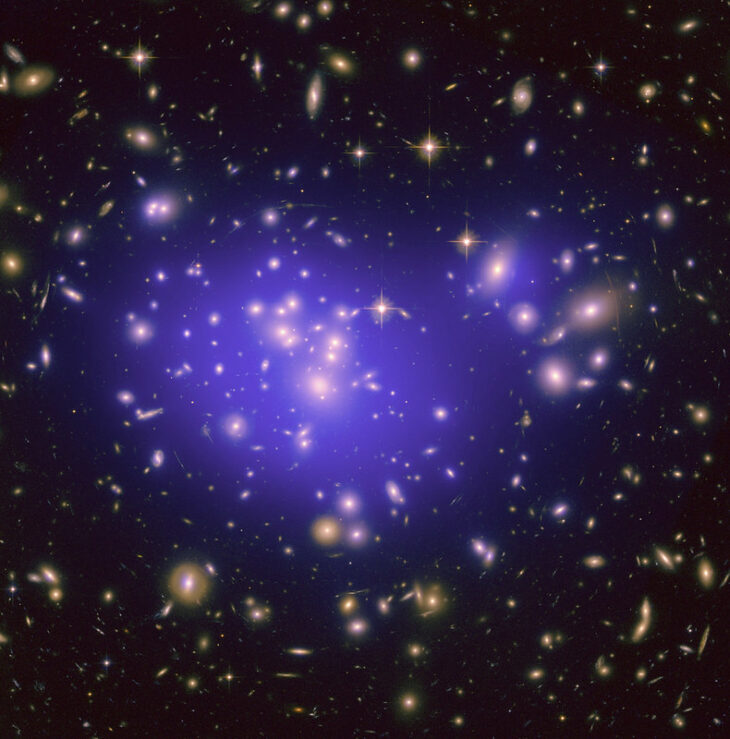Light has a limited speed, so it takes a longer amount of time to travel longer distances. Astronomers can use that fact to study ancient periods of the universe’s history by observing distant objects. Due to the fundamental constraints of geometry and the physics of light, objects appear smaller and dimmer the farther away they are. And if you’re trying to point a telescope at something small, dim, and far away, your view might be blocked by something bigger, younger, and closer.
Under special circumstances, scientists can get around this obstacle and, in fact, use it to their advantage. Just like matter, light is affected by gravity. Specifically, its path of travel gets bent as it passes through a gravitational field. The bigger something is, the stronger the gravitational field it creates, and the more light bends while moving past it.
If you have something enormous like a cluster of galaxies, the light emitted by objects behind it bends so much that their images get distorted and magnified, like they passed through a lens. The phenomenon in which the gravitational force of a massive, closer object magnifies a more distant one is known as gravitational lensing.
A team of astronomers recently observed an ancient galaxy known as A1689-zD1, which is gravitationally lensed by the galaxy cluster Abell 1689. A1689-zD1 is approximately 25 billion light-years away from us now, which is equivalent to 150 sextillion miles or 240 sextillion kilometers. The light we see from it has traveled for about 13 billion years, almost as long as the 14 billion-year lifetime of the universe.
Observing this light allows astronomers to study the properties of the galaxy as they were 13 billion years ago. Scientists think that galaxies at this distance would be in the earliest stages of their formation and evolution, an era they refer to as cosmic dawn. Studying galaxies at cosmic dawn gives astronomers insight into how galaxies form.
To make their observations, the team gathered data from several sources. They used the radio telescope in the Atacama Desert of Chile, called the Atacama Large Millimeter/submillimeter Array, or ALMA, to see light emitted from oxygen and carbon ions in the galaxy. They also used the Green Bank Observatory’s VEGAS spectrometer instrument to look for light emitted from the galaxy’s carbon monoxide molecules. The emissions from these ions and molecules enable astronomers to determine the structure of the galaxy and observe how its different parts move and fit together. Finally, the team combined archived images of A1689-zD1 taken with the Hubble and Spitzer Space Telescopes to create a composite image in ultraviolet and infrared light for comparison with their radio data.
While gravitational lensing can help astronomers by displaying and magnifying an obscured source of light, it also tends to distort the image into a blobby crescent shape. To determine the actual shape of the galaxy, the team had to account for these distortions. For this, they used a model of the light-bending effects of Abell 1689’s gravity using the software Lenstool. The team combined all their data and modeling to precisely describe the dynamics of A1689-zD1 to less than 1% of the Milky Way Galaxy’s width. That comes out to 200 parsecs, which is approximately 4 quadrillion miles or 6 quadrillion kilometers.
The team found that A1689-zD1 was larger than previous researchers had estimated, which was around 2 to 4 billion times the Sun’s mass. The new results suggested it had a total mass of around 20 billion times the Sun’s mass. They found that this material was divided into 5 distinct component regions, each moving differently and clustering in different places. These components also showed no signs of forming a single rotating disk, like the Milky Way’s famous spiral.
They outlined 3 possible explanations for this observation. One was that these regions are all components of a single extended galaxy, taking shape in the form of large molecular clouds and star-forming clusters. Another was that A1689-zD1 actually came from the merger of at least 2 smaller galaxies, and that these distinct regions resulted from the components of merging galaxies colliding and pulling each other apart. Finally, they proposed that the first 2 options were not mutually exclusive, although they couldn’t confirm the degree to which either or both have occurred based on currently available data.
The team suggested that much of this ambiguity could be resolved using follow-up observations with JWST. They also noted that much of A1689-zD1 remains obscured in the wavelength ranges of their study, with the added mystery of a lingering discrepancy between the masses estimated by counting the starlight from the galaxy versus measuring the motion of all the stars. Overall, they concluded that their results suggest that the galaxies at cosmic dawn are diverse and complex.


